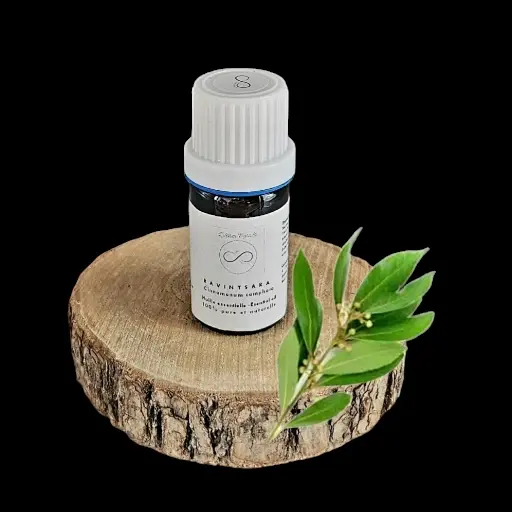Ravintsara essential oil
Botanical name: Cinnamomum camphora cineole
Distilled part: leaf
Botanical family: Lauraceae
Origin: Madagascar
Chemical composition:
- Esters: Terpenyl acetate
- Monoterpenes (27.50%), Alpha and Beta Pinene (high%), P Cymene, Sabinene (14.40%)
- Monoterpenols (13%): Alpha Terpineol (8.65%)
- Oxides: 1.8 Cineole (55.70% Majority)
- Phenols (Traces)
- Phenol Methy-Ethers (Traces)
- Sesquiterpenes (3.80%): Beta Caryophyllene
Prohibited for: pregnant women - babies up to 3 years oldI
Legend: * powerful,** very powerful;*** extremely powerful (power value for the associated pathology)
PHYSICAL PROPERTIES AND THERAPEUTIC INDICATIONS:
- Antiseptic*, Bactericidal*, Virucidal**
- Bronchitis*, Whooping Cough*, Flu**, Expectorant*, Nasopharyngitis*, Sinusitis*
- Viral enteritis*
- Fatigue*, Mononucleosis**, Insomnia**
- Viral hepatitis*
- Herpes* and Genital Herpes*, Shingles**+ Ophthalmological Shingles** (Caution NEVER IN THE EYES)
- Immunostimulant*, General stimulant*
- Neurotonic*
EMOTIONAL, PSYCHIC AND EMOTIONAL PROPERTIES:
- Anguish*
- Depression*
- Energizing*
Help in cases of bereavement, night waking, nightmares, stress with palpitation, exhaustion, melancholy
Reference and bibliographic source: Lily BAYER and Dr Hervé STAUB, (2013) “In-depth treatise on Phyto and Aromatherapy”, Ed. Grancher. p. 632.
INDICATIONS IN AROMATHERAPY AND THE USE OF ESSENTIAL OILS DO NOT CONSTITUTE A MEDICAL DIAGNOSIS AND DO NOT REPLACE THE ADVICE OF A DOCTOR OR MEDICAL TREATMENT !





